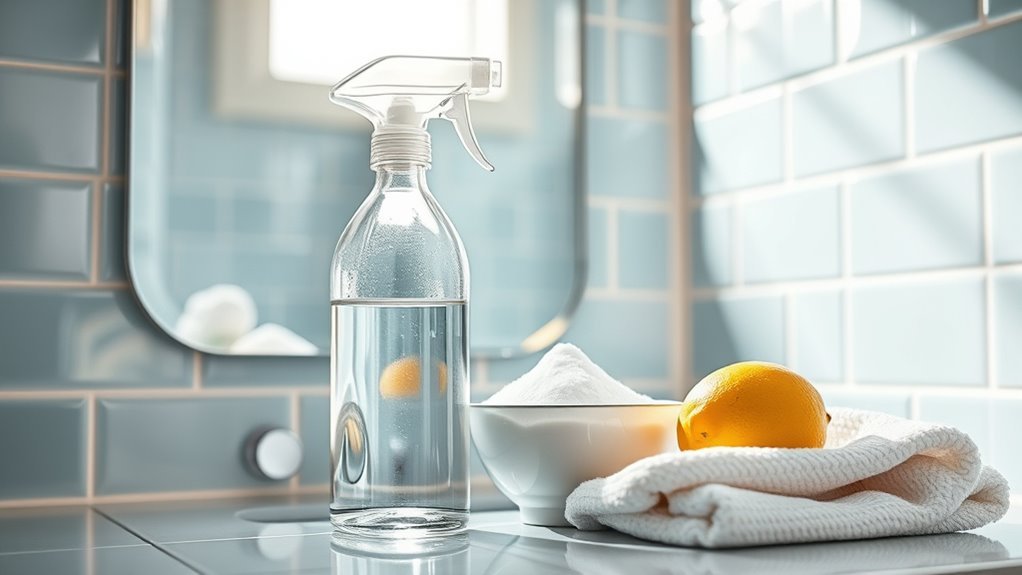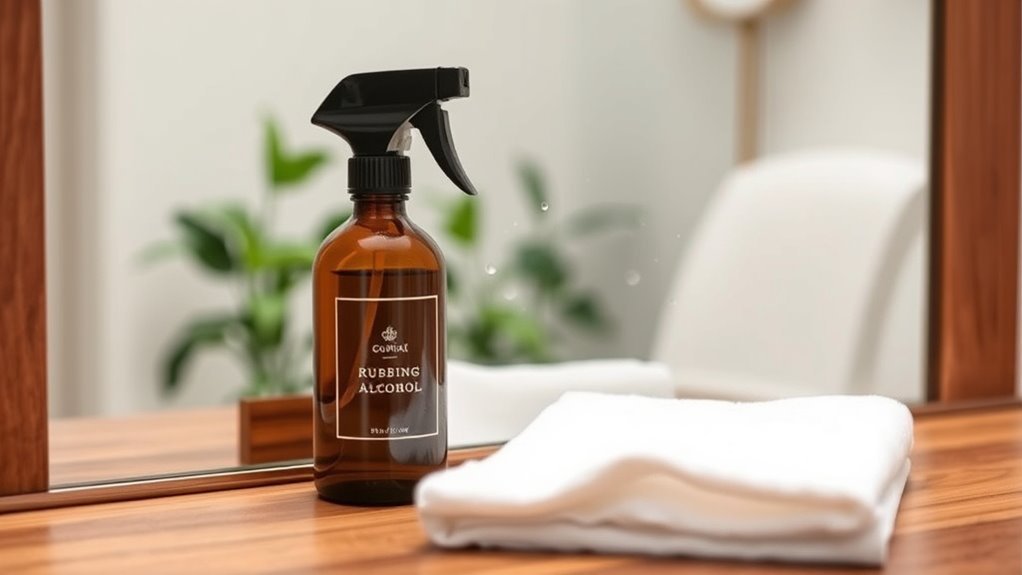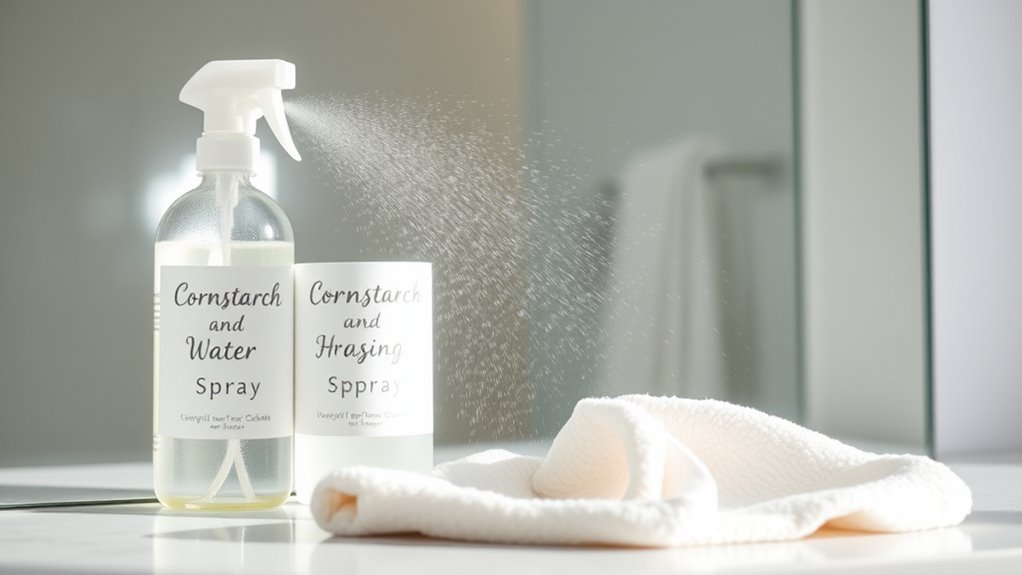Budget-Friendly DIY Cleaning Products for Mirror
You can make budget-friendly mirror cleaners using simple household items like distilled water, vinegar, rubbing alcohol, or castile soap. For example, mixing equal parts vinegar and water or rubbing alcohol and water creates effective, streak-free solutions. Adding essential oils gives a fresh scent, while baking soda paste tackles tough stains gently. Using microfiber cloths and avoiding excess spray prevents streaks. Keep exploring to find easy recipes and tips for sparkling, spotless mirrors without expensive products.
Essential Ingredients for DIY Mirror Cleaners

When making your own mirror cleaner, you’ll want to focus on a few essential ingredients that guarantee streak-free, sparkling results. Opting for natural alternatives like distilled water and rubbing alcohol enhances cleaning efficiency without harsh chemicals. Distilled water prevents mineral deposits that cause spots, while alcohol rapidly evaporates, reducing streaks. Adding a small amount of mild liquid soap can boost grease-cutting power without residue. Essential oils, such as lemon or tea tree, not only freshen the scent but also add antibacterial properties. By combining these ingredients in the right proportions, you create a balanced solution that cleans mirrors thoroughly and safely. This DIY approach gives you control over what you use, supporting your desire for freedom from commercial product limitations while maintaining impressive cleaning efficiency.
How to Make a Vinegar-Based Mirror Cleaner
Building on the key ingredients that make a mirror cleaner effective, vinegar offers a simple and powerful option for your DIY mixture. To make your vinegar-based mirror cleaner, combine equal parts distilled white vinegar and water in a spray bottle. The vinegar benefits include its natural ability to break down grime and dissolve mineral deposits without harsh chemicals. For enhanced cleaning techniques, add a few drops of essential oil for a pleasant scent. When cleaning, spray the mixture lightly on your mirror and wipe with a microfiber cloth using circular motions to avoid streaks. This method not only saves money but also gives you full control over the ingredients you use, aligning with your desire for freedom from commercial products.
Using Rubbing Alcohol for a Streak-Free Shine

You’ll find rubbing alcohol is great for cutting through grime and evaporates quickly, leaving your mirror streak-free. To use it effectively, mix equal parts rubbing alcohol and water in a spray bottle and apply sparingly to avoid damage. Wipe with a lint-free cloth in circular motions for the best shine.
Benefits of Rubbing Alcohol
Although many commercial cleaners promise a streak-free shine, rubbing alcohol often outperforms them by quickly evaporating and dissolving grime without leaving residue. One of the key rubbing alcohol benefits is its ability to cut through oils and dirt effectively, giving your mirror a crisp, clear finish. Plus, its disinfecting properties mean you’re not just cleaning but also sanitizing the surface, reducing bacteria buildup. Because it evaporates fast, you avoid the frustration of streaks or smudges, making your cleaning process quicker and more efficient. Using rubbing alcohol gives you control, letting you maintain spotless mirrors without relying on expensive, chemical-laden products. It’s a simple, budget-friendly solution for anyone who values both cleanliness and freedom from harsh cleaners.
Application Tips for Mirrors
A clean, streak-free mirror starts with the right application technique when using rubbing alcohol. First, mix equal parts rubbing alcohol and water in a spray bottle. Avoid saturating the mirror—light misting prevents drips that cause streaks. Use a microfiber cloth, which is ideal for mirror cleaning techniques due to its lint-free, absorbent nature. Spray the solution onto the cloth, not directly on the mirror, to control moisture. Wipe the mirror in a horizontal or vertical motion, avoiding circular scrubbing that can leave marks. For streak prevention methods, flip to a dry section of the cloth to buff the surface until it shines. Regularly change or wash your cloth to keep it effective. Following these steps guarantees you enjoy a crystal-clear mirror without the hassle of stubborn streaks.
Homemade Lemon Juice and Water Solution
You’ll find that lemon juice naturally cuts through grime and leaves mirrors sparkling without harsh chemicals. A simple mix of one part lemon juice to two parts water works best for cleaning without damaging the surface. To apply, spray the solution lightly and wipe with a microfiber cloth for a streak-free finish.
Benefits of Lemon Juice
Since lemon juice naturally contains citric acid, it’s highly effective at breaking down grime and water spots on mirrors without leaving streaks. When you use a homemade lemon juice and water solution, you’re tapping into its natural disinfectant properties, which help eliminate bacteria and keep your mirror hygienic. Besides its cleaning power, lemon juice imparts a fresh citrus aroma that leaves your space smelling clean and vibrant, unlike harsh chemical cleaners. This simple ingredient is affordable, non-toxic, and eco-friendly, giving you freedom from synthetic products. Plus, its gentle acidity won’t damage your mirror’s surface, making it ideal for regular use. By choosing lemon juice, you’re embracing a practical, budget-friendly approach to mirror care that’s both effective and safe.
Mixing Ratios Guide
Three simple mixing ratios can help you create the perfect homemade lemon juice and water solution for cleaning mirrors. For light cleaning, mix one part lemon juice with four parts water—this gentle ratio removes dust and fingerprints without leaving residue. If your mirror needs a deeper clean, try equal parts lemon juice and water; this balances acidity and dilution for effective grime removal. For stubborn spots, use two parts lemon juice to three parts water, but be cautious—higher acidity might damage delicate surfaces if overused. These DIY cleaning ratios give you flexibility and control, so you can tailor your solution to your mirror’s needs. Experimenting with mixing ratios guarantees you get a streak-free shine while keeping your cleaning routine budget-friendly and eco-conscious.
Application Tips for Mirrors
A few simple application tips can make a big difference when using your homemade lemon juice and water solution on mirrors. First, spray lightly to avoid streaks and wipe with a microfiber cloth for a spotless finish. Follow mirror maintenance tips by cleaning regularly but not excessively to protect the surface. Here are practical cleaning frequency recommendations and application advice:
| Tip | Recommendation |
|---|---|
| Spray Amount | Light, even mist |
| Wiping Cloth | Microfiber, lint-free |
| Cleaning Frequency | Weekly or biweekly |
| Direction of Wiping | Circular motions |
| Drying Time | Immediate drying to avoid spots |
Baking Soda Paste for Tough Mirror Stains
When regular cleaning methods don’t remove stubborn spots, baking soda paste can be your go-to solution for tough mirror stains. Baking soda uses go beyond simple scrubbing; its gentle abrasiveness tackles grime without scratching the glass. To make the paste, mix baking soda with a small amount of water until you get a thick consistency. Apply it directly to the tough stains using a soft cloth or sponge, then gently rub in circular motions. Let the paste sit for a few minutes to break down buildup. Afterward, rinse thoroughly with water and wipe dry with a microfiber cloth. This method frees you from harsh chemicals while effectively lifting tough stains, making it a smart, budget-friendly choice for keeping your mirrors spotless.
Cornstarch and Water Spray for Gentle Cleaning

You only need cornstarch and water to make this gentle cleaning spray, making it both simple and affordable. Just mix one tablespoon of cornstarch with two cups of water until fully dissolved, then pour the solution into a spray bottle for easy use. This mixture helps remove smudges without scratching your mirror, keeping the surface clear and well-maintained.
Simple Ingredients Needed
One of the simplest and most effective homemade solutions for cleaning mirrors involves just two ingredients: cornstarch and water. These simple ingredients create a gentle yet powerful spray that lifts dirt and smudges without harsh chemicals. When you choose this DIY option, you’re opting for:
- Easily accessible pantry staples
- A non-toxic, eco-friendly cleaner
- A product safe for delicate mirror surfaces
- An affordable, budget-friendly option
- A versatile solution for various glass surfaces
Using cornstarch and water as your base means you get effective solutions without complicated ingredients. This minimalist approach lets you maintain your mirrors’ shine while enjoying freedom from expensive, chemical-laden cleaners. By sticking to these simple ingredients, you guarantee clarity and sparkle with ease and peace of mind.
Easy Mixing Instructions
Although the ingredients are simple, mixing your cornstarch and water spray correctly is key to achieving a streak-free shine. Start by combining 1 tablespoon of cornstarch with 2 cups of warm water in a clean spray bottle. Shake vigorously until the cornstarch fully dissolves—no lumps should remain. For an eco friendly option, use filtered water and a reusable bottle to reduce waste. If you want to personalize your cleaner, add a few drops of your favorite essential oil for scent variations, like lavender or lemon, which also boost freshness. Always shake the bottle before each use, as cornstarch can settle. This straightforward mixing method guarantees a gentle, effective cleaner that leaves your mirrors sparkling without harsh chemicals or streaks.
Benefits for Mirror Care
When caring for mirrors, using a cornstarch and water spray offers a gentle yet effective cleaning solution that prevents damage often caused by harsh chemicals. This DIY option supports your mirror maintenance routine by providing a non-abrasive formula that lifts dirt and smudges without scratching surfaces. You get effective cleaning with minimal effort, making it ideal for frequent upkeep. Plus, it’s budget-friendly and eco-conscious, giving you freedom from costly or toxic cleaners. Here’s why this spray benefits your mirror care:
- Reduces streaks and leaves a clear, polished finish
- Avoids chemical residues that degrade mirror backing
- Safe for all mirror types, including antique or coated glass
- Easy to prepare with common household ingredients
- Supports sustainable, cost-effective mirror maintenance
This approach keeps your mirrors spotless and protected with ease.
Crafting a Castile Soap Mirror Cleaner
Start by gathering simple ingredients to craft a Castile soap mirror cleaner that’s both effective and gentle. You’ll need 1 cup of distilled water, 1 tablespoon of liquid Castile soap, and a few drops of your favorite essential oil if you want a pleasant scent. Castile soap benefits include its natural, biodegradable formula that won’t leave streaks or damage your mirror’s surface. Combine these in a spray bottle and shake gently. When using this solution, spray lightly onto the mirror and wipe with a microfiber cloth employing circular mirror cleaning techniques to avoid streaks. This DIY cleaner saves money and gives you control over what’s touching your mirror, offering freedom from harsh chemicals while maintaining a sparkling, clear reflection.
Using Tea Tree Oil for a Fresh and Clean Mirror
If you enjoyed crafting a gentle Castile soap mirror cleaner, you might appreciate the added benefits of tea tree oil for your cleaning routine. Tea tree not only invigorates but also enhances the mirror benefits by naturally disinfecting and preventing mold buildup. To make your own tea tree mirror cleaner, mix a few drops with water and a splash of vinegar or Castile soap. This combo keeps your mirror sparkling and germ-free.
Here’s why tea tree oil stands out for your mirrors:
- Naturally antibacterial and antifungal
- Eliminates odors for a fresher room
- Helps prevent streaks and spots
- Easy to mix with other natural ingredients
- Leaves a subtle, revitalizing scent
Using tea tree oil gives you freedom from harsh chemicals while keeping your mirrors impeccably clean.
Tips for Applying DIY Cleaners Without Streaks
Although DIY cleaners are effective, applying them without leaving streaks can be tricky. To master streak free techniques, start by using a microfiber cloth—its fine fibers lift dirt and moisture without scratching. Spray your homemade solution sparingly to avoid excess liquid that can drip and cause streaks. Clean your mirror in a circular motion, then finish with vertical strokes for even mirror polishing. Work in sections to guarantee no area dries too fast, which leads to streaks. Avoid cleaning mirrors in direct sunlight; heat causes cleaner to evaporate unevenly. Finally, use a dry, clean cloth to buff the surface gently after cleaning. By following these practical steps, you’ll enjoy crystal-clear, streak-free mirrors using your budget-friendly DIY products.
Storing Your Homemade Mirror Cleaning Solutions Safely
After perfecting your technique for applying DIY cleaners without streaks, you’ll want to confirm your homemade solutions stay effective and safe for future use. Proper storing containers and labeling solutions are key to this. Choose airtight bottles to prevent spills and contamination. Always label your containers clearly with ingredients and preparation dates to avoid confusion. Store solutions away from direct sunlight and heat to maintain their potency. Keep them out of reach of children and pets for safety. Here’s what you should focus on:
Store DIY cleaners airtight, labeled, away from sunlight, and out of children’s reach for lasting safety and effectiveness
- Use dark glass or opaque plastic storing containers to protect contents
- Label solutions with names, dates, and safety warnings
- Store in a cool, dry place away from sunlight
- Confirm lids are tightly sealed after each use
- Keep out of reach of children and pets
This approach confirms your DIY mirror cleaners stay fresh and safe.
Frequently Asked Questions
Can DIY Mirror Cleaners Damage Mirror Frames?
You might wonder if DIY mirror cleaners can damage mirror frames. The truth is, it depends on your mirror frame materials and the cleaning solution ingredients you use. Harsh acids or abrasives can harm wood or painted frames, while gentle, natural solutions like vinegar diluted with water usually won’t. Always test a small area first to protect your frames, so you can clean freely without risking damage.
How Often Should I Clean Mirrors With Homemade Solutions?
You should adjust your cleaning frequency based on how quickly your mirrors get dirty, but generally, cleaning them once every two weeks is solid for mirror maintenance. If you notice spots or smudges sooner, go ahead and clean more often. Using gentle, homemade solutions helps keep your mirrors clear without harsh chemicals, giving you freedom from streaks while protecting the surface. Regular upkeep guarantees your mirrors always look their best and last longer.
Are These DIY Cleaners Safe for Tinted or Antique Mirrors?
Did you know 60% of antique mirrors have delicate backing that harsh cleaners can damage? For tinted mirror safety, avoid acidic ingredients like vinegar; opt for mild soap and water instead. When it comes to antique mirror care, use a soft cloth and gentle solutions to prevent deterioration. By choosing the right DIY cleaners, you’ll keep your mirrors spotless without risking damage, giving you freedom to maintain their charm safely and effectively.
Can I Use These Cleaners on Other Glass Surfaces?
You can definitely use these DIY cleaners on other glass surfaces beyond mirrors. Since they’re designed for mirror cleaning, they’re gentle yet effective enough for windows, glass tabletops, and even glass doors. Just make sure to test a small area first to avoid any potential damage, especially on tinted or specialty glass. This way, you keep your glass surfaces sparkling clean while enjoying the freedom of easy, budget-friendly solutions.
What Should I Do if My Mirror Still Has Streaks?
If your mirror still has streaks, don’t worry—you can fix it with some effective streak removal techniques. Start by wiping the mirror with a microfiber cloth, which minimizes streaks. Use a homemade cleaner with equal parts water and vinegar for better results. Make sure to clean in a circular motion, then finish with vertical strokes. Remember, mirror cleaning tips like avoiding paper towels and cleaning on a cloudy day can also help you achieve a streak-free shine.






